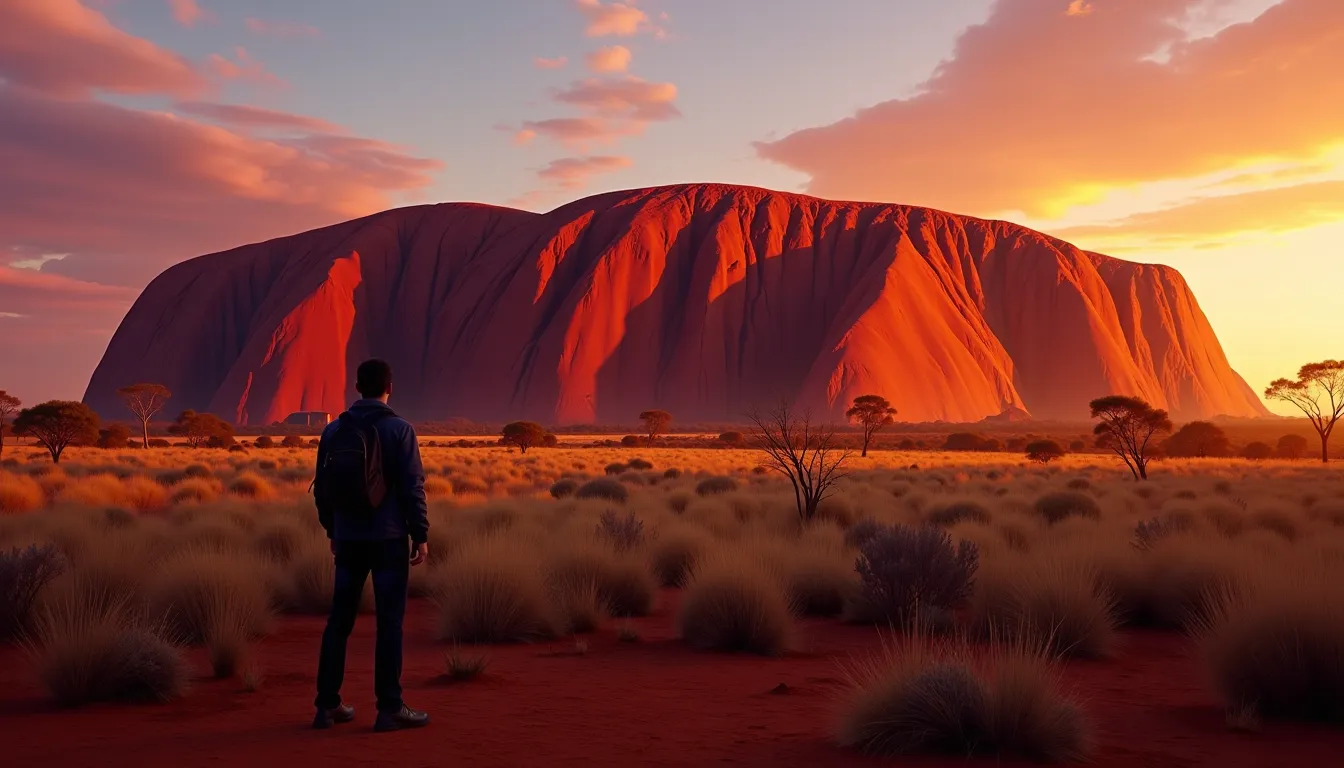In the heart of Australia’s Red Centre lies a place where ancient stories whisper through the wind-sculpted sandstone: Uluru-Kata Tjuta National Park. This UNESCO World Heritage site isn’t just a feast for the eyes; it’s a profound journey into the spiritual core of the world’s oldest living culture. As the sun rises over the vast desert landscape, Uluru – the iconic monolith standing 348 meters tall – transforms from deep purple to blazing red, a daily spectacle that has captivated humans for millennia.
The Monolith That Defies Imagination
Uluru isn’t just big; it’s a geological anomaly that challenges our perception of scale. Stretching 9.5 kilometers in circumference, this sandstone behemoth is the world’s largest monolith. But it’s what lies beneath that truly astounds – the rock extends several kilometers underground, like a colossal iceberg of the outback.
“Uluru is not just a rock, it’s a living library of our people’s history and knowledge,” shares Sammy Wilson, an Anangu elder and park ranger. “Every crevice, every shadow tells a story passed down through generations.”
Kata Tjuta: The Often Overlooked Sister Site
While Uluru steals the spotlight, Kata Tjuta – meaning “many heads” in the local Pitjantjatjara language – offers an equally mesmerizing experience. This collection of 36 dome-shaped rock formations spread across 20 kilometers creates an otherworldly landscape that feels like stepping onto another planet.
Walking in the Footsteps of Dreamtime
The Anangu people have been the custodians of this land for over 60,000 years. Their connection to country runs deep, intertwining creation stories with the physical landscape. Joining a guided tour led by an Anangu elder is like unlocking a hidden layer of reality, where every rock formation and plant holds profound meaning.
The Controversy of the Climb
For decades, tourists flocked to Uluru to conquer its steep slopes. However, in 2019, the climb was permanently closed out of respect for Anangu wishes and the site’s cultural significance. This shift marks a new era of responsible tourism, focusing on understanding rather than conquering.
A Symphony of Color at Dawn and Dusk
Witnessing Uluru at sunrise or sunset is a transformative experience. As the light shifts, the rock seems to pulse with life, changing from deep burgundy to fiery orange and back again. It’s a natural light show that rivals any man-made spectacle.
Beyond the Rock: Unexpected Wonders
While Uluru dominates the imagination, the park holds other surprises. The Field of Light installation by artist Bruce Munro blankets the desert floor with 50,000 solar-powered spheres, creating a magical nighttime landscape that complements the ancient beauty of Uluru.
Connecting with Country Through Bush Tucker
Exploring the park’s flora reveals a bounty of traditional foods and medicines. Guided bush tucker walks offer insight into the Anangu’s deep knowledge of the land, teaching visitors about sustainable living in one of Earth’s harshest environments.
Stargazing in the Heart of Darkness
Far from city lights, the night sky above Uluru-Kata Tjuta is a celestial wonderland. The Milky Way stretches across the heavens in breathtaking clarity, offering a humbling perspective on our place in the universe.
Challenges and Respect in a Sacred Landscape
Visiting Uluru-Kata Tjuta comes with responsibilities. The extreme heat and vast distances require careful planning. More importantly, travelers must approach the park with reverence, respecting sacred sites and cultural sensitivities.
“We welcome visitors who come with an open heart and mind,” says Jennifer Yirrmal, an Anangu artist. “This is a place of learning and connection, not just a backdrop for photos.”
A Gateway to Australia’s Ancient Heart
Uluru-Kata Tjuta National Park is more than a destination; it’s a portal to understanding Australia’s ancient soul. It invites travelers to slow down, listen deeply, and connect with a landscape that has shaped human experience for tens of thousands of years.
For those seeking to delve deeper into Australia’s indigenous heritage, consider exploring Australia’s ancient gorges, where hidden canyons reveal more indigenous secrets. And if you’re drawn to the allure of natural wonders, don’t miss the chance to discover Vietnam’s hidden 300-meter waterfall for another awe-inspiring adventure.
As the sun sets on your journey through Uluru-Kata Tjuta, you’ll carry with you not just memories of stunning vistas, but a profound sense of connection to one of the world’s most ancient and enduring cultures. This isn’t just a trip; it’s a pilgrimage to the very heart of Australia’s spiritual landscape.
